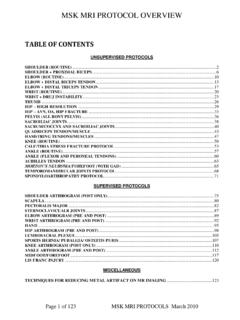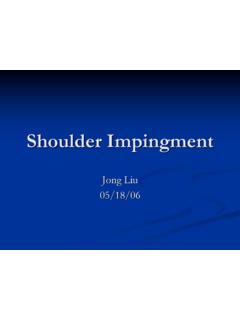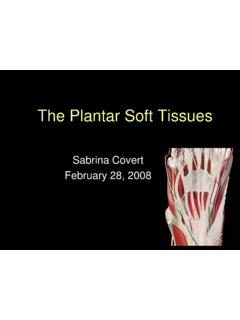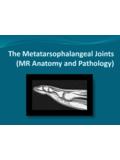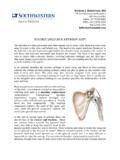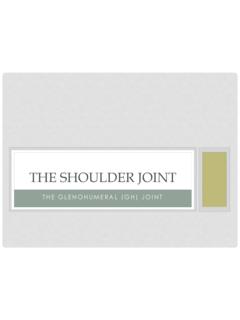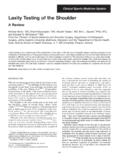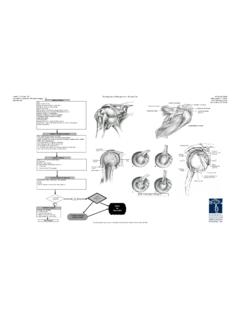Transcription of Rotator cuff shoulder - bonepit.com
1 1Dr. Mini N. Pathria , FRCP(C)Department of RadiologyUniversity of California School of MedicineSan Diego, CaliforniaMR Imaging of the shoulder : Rotator CuffRotator cuff Acute Trauma Calcific tendinitis Degenerative Tendinosis Impingement syndrome TearTraumaWB< 10% of Rotator cuff tearsTraumaSlipped on bathroom mat, MRTraumaJOTendon calcificationSilent phaseActive phase2 Tendon calcificationLTCalcium Hydroxyapatite Deposition Disease (HADD)Ca10(PO4)6(OH2) Calcific tendinitisCalcific tendinitisMJCalcific tendinitisKGRotator cuff degeneration Impingement Aging and degeneration of the cuff Ischemia of critical zone Glenohumeral instability Repetitive traumaSBRotator cuff degenerationCritical zone3 Impingement syndromeNeer Entrapment of soft tissues between humeral head, acromion and coracoacromial arch Leads to subacromial bursitis, Rotator cuff edema and hemorrhage.
2 And ultimately Rotator cuff tearBursal thickeningRMSubacromial bursitisSubacromial bursitis Impingement Calcific tendinitis Infection Inflammatory synovitisRA, BBImpingement syndromeAcromioclavicular joint osteoarthritsAcromial morphologyType 1 "Flat"Type 2 "Curved"Type 3 "Hooked"High rate of RCTs Shape of undersurface of acromion in sagittal plane one or two slices lateral to AC joint Association of acromial morphology with risk of impingement and Rotator cuff tearBigliani et al, Orthop Trans 10:216, 19864 Acromial morphologyType 1 Type 3 Type 2 Subacromial spurJESubacromial spurAcromial morphologyLaterally down-slopingLow-lyingOs acromionale Can lead to impingement of infraspinatus due to bony ridge on undersurface Can be hypermobile.
3 Causing pain and dynamic impingment Acromial decompression often unsuccessful in presence of os acromionaleSRRCOs acromionalePre-acromionMeso-acromionMeta -acromion5 Subcoracoid impingment Normal 4-11 mm Subcoracoid impingement <6 mm Coracoid tip sclerosis Cystic changes of humeral head or lesser tuberosity Subcoracoid bursitits Tear of subscapularisPEFriedman RJ et al, Cine MRI of the subcoracoid region. Orthopedics 21:545, 1998 Subcoracoid bursaSchraner AB et al, AJR 176:812, 2001 Tendinopathy Increased signal on T1 and PD Normal signal on T2 Alteration in tendon size or morphologyMagic angle Field orientation artifact in collagen causing focal T2 prolongation Artifact maximal when tissue is oriented at 55 to main magnetic field Most prominent on short TE sequences Disappears on long TE sequences Normal tendon morphology and sizeRSTendinopathyNonfatsat T2 and IR, WTendinopathy Partial tear6 Partial Rotator cuff tearsBursal sideArticular sideInterstitialPartial tear bursalHEPartial bursal sided tear.
4 EAPartial tear bursalMR arthrography, JWPartial tear bursalT2-w FSEP artial tear articularIncreased sensitivity for partial articular sided tears with MR arthrographyInsertional tear Peel-back Rim rent tear PASTA lesion Partial Articular Surface Tendon Avulsion Concealed tear7 Insertion peel-backInsertional tearCRInsertional tearRBInterstitial tearPartial intrasubstance tear, RRConcealed lesionRotator cuff layersMichael Stadnick, RadsourceLayer I is superficial, measures 1 mm and is composed of fibers from the coracohumeral ligament which extend posteriorly and obliquely.
5 Layer II is composed of densely packed fibers that parallel the long axis of the tendon and measures 3-5 mm in thickness. Layer III is 3 mm thick and composed of smaller bundles of collagen which are loosely organized at an approximately 45 angle to the long axis of the tendon. Layer IV is composed of loose connective tissue and thick collagen bands and merges with fibers from the coracohumeral ligament. Layer V is the shoulder capsule and measures approximately 2 mm in cystSCSanders TG et al, Association of Intramuscular Cysts of the Rotator Cuff With TearsPTDifferential retractionRetraction strap componenet refSBFull thickness tearFull thickness tear Retraction of tendon Tendon discontinuity with fluid in gap Focal increased signal on T2w in tendon Severe attenuation or irregularityMR arthrogram.
6 DT9 Full thickness tear Tears preferentially involve anterior fibers of supraspinatus Peripheral sagittal imagesFull thickness tearATRetraction and pseudotendon formation, Myotendinous junction End of muscle fibers of supraspinatus Normal myotendinous junction lies above center of humeral head Furthest normal position medially is at 1:00 o clock position55%6%33%7%adapted from Steinbach LS et al, shoulder Magnetic Resonance Imaging, Lippincott-RavenRetractionMRA, FVSBC omplete tear Tendon torn all the way from anterior to posterior High-riding humerus Erosion of undersurface of acromion and superior humeral headJC10 Rotator cableBurkhart et al, The Rotator crescent and Rotator cable.
7 Arthroscopy 9:611-6, 1993 Superior (left) and posterior (right) projections of the Rotator cable and crescent. The Rotator cable extends from the biceps to the inferior margin of the infraspinatus tendon, spanning the supraspinatus and infraspinatus tendon insertions. B, mediolateral diameter of Rotator crescent; C, width of Rotator cable; S, supraspinatus; I, infraspinatus; BT, biceps tendon; TM, teres cable Rotator cable Thickening of the capsule derived from the coracohumeral ligament that surrounds the distal SS and IS tendons. It is consistently located at the margin of the avascular zone Rotator crescent Thin, crescent-shaped sheet of Rotator cuff comprising the distal portions of the supraspinatus and infraspinatus insertionsRotator cable In cable dominant shoulder there is less retraction with RCT and less loss of function In cable non-dominant shoulder .
8 The tear usually extends to MTJ and is therefore harder to repair Detachment of 1/2 or 2/3 of supraspinatus tendon in the crescent area has minor effect on the force transmission of the Rotator cuff because these forces are transmitted along the Rotator cuff cable, bypassing the tearBurkhart et al, The Rotator crescent and Rotator cable. Arthroscopy 9:611-6, 1993U-shaped tearRotator cableInfraspinatusNKInfraspinatusInterna l rotation11 Infraspinatus tearInfraspinatus tearInfraspinatus retraction, HrefSubscapularisSubscapularis Isolated tear of the subscapularis tendon is usually traumatic External rotation and hyperextension of abducted arm Anterior shoulder dislocation or recurrent anterior shoulder instability Near bony insertion on the lesser tuberosity May have avulsion of the tuberosity and associated internal malpositions of the biceps tendon, GHL injury and HAGL lesionISGerber et al.
9 Isolated rupture of the subscapularis tendon. JBJS 78:1015, 1996 Subscapularis tearKBSubscapularis tearTS12 Subscapularis tearCRRotator cuff interval Triangular space located between supraspinatus, subscapularis, and base of the coracoid Floor is humeral head Roof is Rotator interval capsule, largely made up of coracohumeral ligament (SGHL provides contributions peripherally) Contains biceps tendon and SGHLM orag et al, Radiographics 235:21, 2005 Krief, AJR 184:1490, 2005 Rotator intervalEM Wide medially, narrows laterally Capsule blends with Rotator cuff at humerusCoracohumeral ligamentRotator intervalGBRotator intervalGBRotator cuff interval tear Can be torn in association with supraspinatus or subscapularis tear or tear can be isolated Tear exposes biceps tendon Tear of Rotator interval difficult to diagnose with MR13 Adhesive capsulitisGCRheumatoid arthritisAtrophy Important predictor of surgical outcome Loss of >50% of muscle volume correlates with poor outcome Significant fatty atrophy (fat equal to muscle)
10 Poor prognostic indicatorZanetti et al, Invest Rad 33:163, 1998 Proton MR Spectroscopy, Pfirrmann et al Radiology 232:709, 2004 Atrophy Assess size of supraspinatus on sagittal view using tangent line Mellado et al, AJR 184:1456, 2005 AtrophyFatty infiltrationVolume lossCan be masked by muscle edemaAtrophy14 High-ridingDOHigh-ridingDeltoid dehiscenceJLDeltoid dehiscenceJLDr. Mini N. Pathria , FRCP(C)Department of RadiologyUniversity of California School of MedicineSan Diego, CaliforniaMR Imaging of the shoulder
